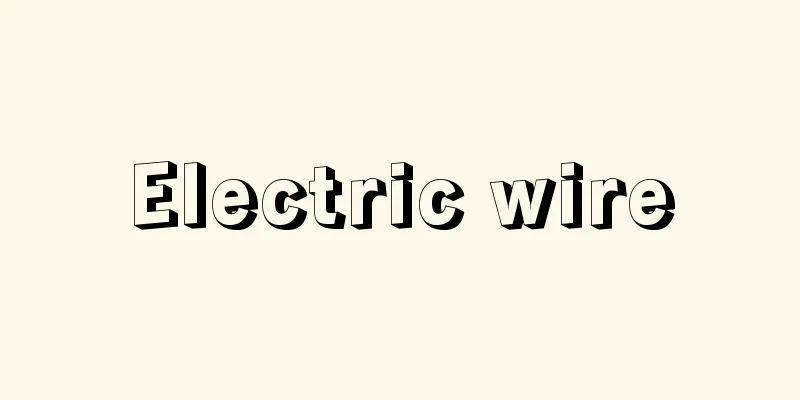Electric wire

|
A wire for conducting electricity. There are bare wires that are just conductors, and insulated wires that are covered with an insulating coating. A cable is an insulated wire or a twisted combination of insulated wires that is covered (sheathed) to protect the insulation, and in electrical work, they are used differently depending on the installation location. In the broad sense, cables are sometimes called electric wires because they conduct electricity. Electric wires can be broadly categorized into power wires that transport electricity (such as power cables and steel-core aluminum stranded wire), communication cables that transmit electrical signals, and windings that are wound in coils inside generators and motors and contribute to energy conversion. The origins of electric wire manufacturing in Japan are unclear. The only known dates are that in 1832 (Tenpo 3), the ancestor of Hirakawa Seisen made copper wire in Osaka, and in 1854 (Ansei 1), Tsuda Kobei of Tsuda Electric Wire began drawing copper wire using a waterwheel in Kyoto. Since electric wires are used to carry electric current, they must have as little electrical resistance as possible and as little power loss as possible. Therefore, it is desirable for the conductive material of electric wires to have as little electrical resistance as possible, be easy to work with, and be mechanically strong. Considering economics, copper, aluminum, and their alloys are widely used, with copper being the most widely used. In Japan, the thickness of solid wire is expressed in millimeters, but there are also numerical indications such as AWG (American Wire Gauge, also known as Brown and Sharpe's Gauge) in the United States and SWG (Standard Wire Gauge) in the United Kingdom. For example, AWG number 10 has a diameter of 2.588 millimeters, and SWG number 10 has a diameter of 3.251 millimeters. Copper wire is made by making wire rods from electrolytic copper with a purity of over 99.96% through electrolysis, and then drawing them to a wire of the specified thickness. There are three ways to make wire rods. The traditional method is the "copper rod rolling method," in which electrolytic copper is melted in a melting furnace and poured into a mold to make wire rods (wire bars). Copper rods are shaped like railroad ties, and come in a variety of weights ranging from 113 kg to 180 kg. The copper rods are heated to about 800°C in a heating furnace, and while still hot, they are rolled by passing them through grooved rolls several times in succession to make wire rods. The diameter is generally 8 mm. The surface of wire rods is covered with black copper oxide because it is rolled at high temperatures, so they are immersed in a dilute sulfuric acid solution to remove the copper oxide. The "continuous casting and rolling method" is used to make wire rods by continuously melting, casting, rolling, pickling, and coiling electrolytic copper. One coil weighs 3 to 5 tons. In the "dip forming" method, a thin copper wire is run through molten electrolytic copper, where the copper solidifies and adheres to the surface of the base material, thickening it, and then this is continuously rolled to make a wire rod. The wire rod is then put into a wire drawing machine, and passed through a number of dies in succession (metalworking molds) to gradually draw it thinner and thinner until it is finished into a wire of the required thickness. Some of the thinnest wires are as thin as one-tenth the width of a human hair. Since around 2000, electric cables that use superconductors and can carry large currents with very low loss have been developed. For the purpose of power transmission, power cables using copper oxide superconducting wires of the bismuth (Bi) or yttrium (Y) systems have been used in demonstration tests in Japan, the United States, and other countries. Low-temperature metal-based superconducting wires such as niobium-titanium (NbTi) and niobium-tin alloy (Nb 3 Sn) are already being used in medical MRI (magnetic resonance imaging) devices, NMR (nuclear magnetic resonance) devices for natural science research, accelerators and nuclear fusion experimental reactors for high-energy physics research, and coil windings for superconducting magnetic levitation trains currently under development. Coatings are explained in the "Communication Cables" and "Power Cables" sections. [Teruo Sakuma and Yoshiji Oki] [Reference] | | |©Shogakukan "> Diagram of main applications of electric wires Source: Shogakukan Encyclopedia Nipponica About Encyclopedia Nipponica Information | Legend |
|
電気を導くための線のこと。電線には、導体のみの裸電線と絶縁被覆を施した絶縁電線とがある。絶縁電線単独または複数本撚(よ)り合わせたものに、絶縁体の保護のため被覆(シース)を施したものをケーブルとよび、電気工事などでは、敷設場所に応じて使い分けられる。広い意味では電気を導くことから、ケーブルを電線とよぶこともある。 電線を大別すると、電力を輸送する電力用電線(電力ケーブルや鋼心アルミ撚り線など)、電気信号を伝送する通信ケーブル、発電機やモーターなどの内部にコイル状に巻かれエネルギー変換に寄与する巻線がある。 日本での電線製造の起源は明らかではない。年代のはっきりしたところでは、1832年(天保3)大坂で平川製線の先祖が銅線をつくっており、1854年(安政1)京都で津田電線の津田幸兵衛が水車を用いて銅線を引き始めている。 電線は電流を流すためのものであるから、電気抵抗はなるべく小さくし、電力損失が小さいものが要求される。したがって、電線の導電材料は電気抵抗がなるべく小さく、加工性がよく、機械的に強いものが望まれる。経済性も考えると、銅とアルミニウムおよびそれらの合金が広く使用されており、ことに銅がもっとも広く使われている。単線の太さは日本では直径をミリメートルで表すが、番号表示でアメリカのAWG(American Wire Gauge、別名Brown and Sharpe's Gauge)、イギリスのSWG(Standard Wire Gauge)などがある。たとえばAWGナンバー10は直径2.588ミリメートルであり、SWGナンバー10は直径3.251ミリメートルである。 銅線は、電気分解でつくった99.96%以上の純度をもつ電気銅から荒引線(ワイヤーロッド)をつくり、伸線して所定の太さの線に仕上げる。荒引線の作り方には3種類ある。古くから行われている方法は「さお銅圧延法」で、電気銅を溶解炉で溶かして鋳型に流し込み、さお銅(ワイヤーバー)をつくる。さお銅は鉄道の枕木(まくらぎ)のような形をしたもので、1本の重さは113キロ~180キログラムまでの各種がある。さお銅を加熱炉で約800℃に加熱し、熱い間に溝付きロールに連続的に何回も通して圧延し、荒引線にする。直径は8ミリメートルが一般的である。荒引線は高温で圧延されるため、表面が黒色の酸化銅で覆われているので、この酸化銅を除去するため希硫酸溶液に浸す。「連続鋳造圧延法」は電気銅の溶解、鋳造、圧延、酸洗い、コイル巻きを連続的に行って製造する。1コイルが3~5トンである。「ディップ・フォーミング法」は、電気銅の溶解した中へ母材の細い銅線を走らせ、母材表面に銅を凝固付着させて太くし、これを連続して圧延し、荒引線をつくる。荒引線を伸線機にかけ、連続して何枚ものダイス(金属加工用の型)を通してだんだんと細く引き伸ばし、所要の太さの線に仕上げる。細いものでは、直径が髪の毛の10分の1ぐらいのものもつくられている。 また、2000年ごろから、超伝導体を用いて超低損失で大電流を流せる電線も開発されている。電力輸送の目的には、ビスマス(Bi)系やイットリウム(Y)系の銅酸化物系超伝導線を用いた電力ケーブルが、日本やアメリカ等で実証試験に供されている。また、ニオブ‐チタン(NbTi)やニオブ‐スズ合金(Nb3Sn)などの低温金属系超伝導線は、すでに、医療用のMRI(磁気共鳴映像法)装置、自然科学研究用のNMR(核磁気共鳴)装置、高エネルギー物理研究用加速器や核融合実験炉、あるいは開発中の超伝導磁気浮上式鉄道のコイル用巻線などとして使用されている。被覆については、「通信ケーブル」および「電力ケーブル」の項目で解説する。 [佐久間照夫・大木義路] [参照項目] | | |©Shogakukan"> 電線の主要用途図 出典 小学館 日本大百科全書(ニッポニカ)日本大百科全書(ニッポニカ)について 情報 | 凡例 |
<<: Electric wire industry - densen kougyou (English spelling) electric wire industry
>>: Legendary Song - Densetsuka
Recommend
British Overseas Airways Corp.
…It has been flying to Japan since 1948, followin...
Bobovac
…As for painting, it did not have the same intern...
Cloister
…At the end of ancient times, cloisters were also...
Exercise folds - Exercise folds
…There are horizontal wrinkles at the bends of ea...
Auxotrophic mutants - Auxotrophic mutants
…The types of substances required vary from speci...
ḥājib (English spelling)
The name of an official position in Islamic countr...
Heterogony
…It is a term used to describe the change in form...
Section Chief - Kakaricho
A position in a government agency or company. The ...
Maymun al-Qaddah
...After Ismail's death, a group of people wh...
Dolerite - dolerite
Also called dolerite. A medium-grained igneous ro...
Wenseki - Wenseki
...Boundary marking devices similar to shimenawa ...
Corpus cavernosum - Kaimentai
This is the main tissue of the penis and clitoris...
Nadar (English spelling)
…A prominent South Indian politician and popular ...
Ryogen
A Tendai Buddhist monk in the mid-Heian period. H...
Escoffier, GA - Escoffier
… [history] From the mid-19th century onwards, la...

![Urakawa [town] - Urakawa](/upload/images/67cb00c26af1d.webp)







